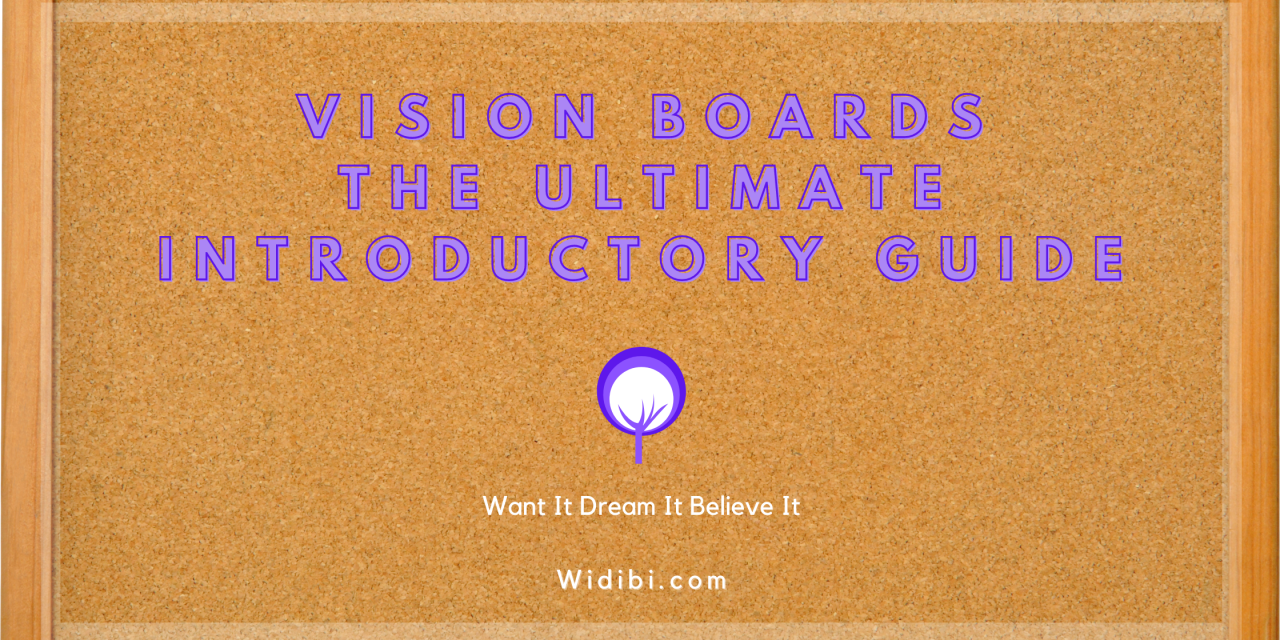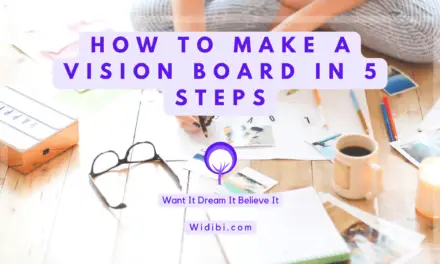Last Updated on May 31, 2022 by Widibi
Vision boards are an essential part of the toolbox of anyone that wants to optimise their organisation skills and fulfil their potential. There are numerous approaches and an infinite combination of designs, styles and placement. In this ultimate introductory guide, I want to touch on the basics of vision boards, what to expect and how to get started without delay.
In This Article
What Are Vision Boards?
A vision board is a piece of work that displays goals, ambitions and anything else you have in mind. Traditionally created on large sheets of card and paper and combined with pictures, words and quotes, the idea behind these boards has evolved in line with technology. Today, any time you put down things you’d like to have or achieve, you have something that you could comfortably call a vision board.
Who Invented Vision Boards?
This is a valid question, but not one that I feel anyone could ever answer with complete certainty. The definition of vision boards is so flexible that there’s an all but infinite number of examples scattered throughout human history. Even cave paintings from the earliest humans may have been vision boards in a way, as they may depict people they wish to meet or what they want to eat. Until such a time as we can go back and ask them, we’ll never know for sure!
Are Vision Boards Part of the Law of Attraction?
Yes and no. Many people, especially those that observe and practice the law of attraction, feel that vision boards and the law of attraction complement each other perfectly. They create their vision boards in such a way that they believe that the universe immediately springs into action, putting everything in place to ensure the manifestation of what appears on the board. Vision boards are also mentioned extensively in books and other media concerning the law of attraction, and many people explore the law before moving on to different techniques used to make things happen.
However, while there is a close relationship between vision boards and the law of attraction, it is not an exclusive one. I previously had the pleasure of working with a charity that focuses on providing employment skills to young people, and vision boards represent a core component of their programmes. Conversely, the law of attraction and its principles don’t receive a solitary mention.
So why do they include them at all? The reasons are twofold and have nothing to do with the manifestation of dreams – at least not directly.
Vision boards serve as a creative, interactive introductory tool, especially for students. I can’t speak for everyone, but you may well remember people at school that preferred their own company or were difficult to communicate with, especially among people that they’ve never met before. The charity in question does a lot of in-classroom learning, and vision boards, when positioned early in a session, served as the perfect opportunity to bring students out of their shells.
The other reason is that it’s not hard to see how a vision board can aid in collecting your thoughts and displaying them in an easy to digest manner. The importance of this cannot be understated, especially when looking for a job or seeking to make a great impression. Jobs and employment-related goals rank only behind money, cars, houses and love in popularity for display on vision boards. That goes for whether the creator has an interest in the law of attraction or not.
Vision Boards and the Law of Attraction
As someone with a personal interest in the law of attraction, I’ll start things off in this section with the relationship between vision boards and the law.
Something I often mention when writing here at Widibi is the importance of being clear, concise and specific when using the law of attraction for manifestation. My favourite metaphor involves using the law of attraction for manifestation in the same manner as you’d order something online from Amazon. If you went on there and ordered a saucepan, you’d have two problems. Firstly, you could end up with a pan of any size, shape, colour or brand, and potentially one that doesn’t work with your style of cooker. Fortunately, the second factor overrides the first – you’d end up receiving nothing at all. The person that comes to your door a day or two later to deliver something will never arrive because neither he nor the warehouse workers have any idea what it is that you really want.
A vision board makes it easy to specify precisely what you want. Metaphors, quotes and vague ideas are all perfectly suited to vision boards too, but I’m a firm believer in the opportunity to be specific. If you just think about the new car you want, details can change, and the specifics remain fuzzy. However, if you take the time to look online or in magazines and find the exact car you want, you can transfer that picture onto your vision board. Then, the universe can make the necessary arrangements to bring that vehicle into your life, while you can focus on doing everything you can to make it happen from your end. The universe doesn’t need help, but it appreciates it, and anything that speeds up the process is worthwhile as far as I’m concerned!
The intrinsic link between vision boards and the law of attraction involves clarifying your thoughts and goals and putting them on display. If nothing else, that display will ensure that you never lose sight of these goals. When combined with affirmations, law of attraction scripting and any other manifestation techniques that you find work for you, regularly seeing what you’re working towards will inform what you should focus on when using other tools and techniques.
Can Vision Boards Work with the Law of Attraction Unintentionally?
I don’t necessarily want to put the law of attraction and vision boards together into a single entity as I feel like they can and do work independently. However, there’s nothing to say that there isn’t an element of the law of attraction involved in vision boards whether you know it or not.
The concept of the law of attraction is inherently unprovable. While I follow it and feel that I benefit from it, I take nothing away from anyone that has no interest in it. Indeed, the number of non-believers is much larger. After all, it includes people that have never heard of or tried the concept, and those that did try but didn’t see any significant results. I never shy away from the fact that I was fortunate. The first time I heard about the law of attraction was the first time I saw it in action. Lots of people believe things that they have never witnessed first-hand – you’d go crazy if you didn’t. However, when you experience the law of attraction for yourself, it’s difficult not to believe, especially when the benefits keep on coming.
I don’t consider vision boards as being magical. Indeed, I don’t consider the law of attraction as being magical either. In all honesty, I don’t put that much thought into it. Do I have a scientific reason for it working? Not at all.
To answer the question, I’m sure that vision boards can indeed work with the law of attraction unintentionally. However, to do so, the individual involved would probably have to unintentionally do other things associated with the law too. If they’re naturally a generous, positive person, they’ll attract positivity anyway.
What is a Vision Board Without the Law of Attraction?
Let me be clear in saying that you don’t need to believe in the law of attraction to benefit from a vision board. One of my closest friends has built his life and career on and around vision boards. He makes several vision boards each week and has used them ever since school to plan out the optimal outcome of everything he does. He now speaks on the subject of vision boards successfully.
He knows of the law of attraction in passing. He has never read The Secret or Think and Grow Rich. I consider them essential reading for anyone with a new or established interest in the law of attraction. They mean nothing to him. Thanks to vision boards, he wrote a book of his own on that very topic. If I remember rightly, the law of attraction is mentioned once, and that is only in passing and to reinforce this point – you don’t need an interest in the law to make vision boards and dream boards work for you.
Without the law of attraction, a vision board becomes an active exercise where you seek to visualise your dreams, goals and ambitions, and do so in a way where a quick glance is the only reminder you need of what you’re working towards.
What is the Purpose of a Vision Board?
I’ve said enough on the law of attraction for this article. The short answer is that it can be a core component of your activities with regard to manifesting your dreams, but it can equally have nothing at all to do with that concept. Indeed, there are many uses and purposes to a vision board. I use them to set goals and keep them at the front of my mind. A charity I worked with uses them as an icebreaker in classroom-based and online virtual workshops.
For me, the most important purposes of a vision board are:
- The opportunity to devote time and uninterrupted thought to think about exactly what you want from life, whether that’s an achievement, material gains or self-improvement.
- The act of seeking out and displaying a picture, quote or word/sentence to place on your vision board, either literally or metaphorically representing your ambitions.
- Serving as a frequent reminder of what you really want when your mind is clear, and your thoughts are uninhibited.
While I’ve got better at avoiding it recently, I would still consider myself as being a procrastinator. In years gone by, I’ve been fairly accused of being lazy at times! Vision boards have helped me to put both of these things right.
I take the time to create or update a vision board once each week. I consider this as being separate to my instant vision boards, which live fluidly on my computer. I still feel there’s plenty of room for a more traditional vision board, displayed on a wall in a prominent position. I don’t go down the card and magazine cut-outs route, as it seems like overkill nowadays. Instead, I’ll create my vision board online and print it out. I have to admit that this is helped along massively by the fact that I have an A3 printer – A4 vision boards don’t quite cut it for me, especially when I haven’t got my glasses on! Incidentally, if you prefer the digital approach, there’s nothing wrong with designing in A3 and printing in A4, then placing them side by side.
Where Should I Put a Vision Board
Putting aside the debate for and against the law of attraction and its relationship with vision boards, it is essential to put your vision board somewhere that you’ll see it often. As I talked about above, one of the most important reasons to have a vision board is that it’s always on hand to remind you of what you should be doing when you’re in a lull or lacking direction. It can’t help with that if you can’t see it.
If you also go with the traditional approach to vision boards and either make it with paper or card or create digitally with the intention of printing it out, a wall space is a perfect place to position it. Think about what’s on your vision board and when you might need it most, then put it somewhere that you’re likely to see it often.
I spend most of my time sitting at a desk. While not everything on my vision boards relates to work (in fact, very little does), I closely associate the things on my vision board with putting in the effort. If I work, I get paid, and I can eventually afford the material items on my board, whether the law of attraction chooses to intervene or not. That can be houses, cars or anything else where the limiting factor between it being on your board and in your life is a financial one.
It doesn’t necessarily have to be the same for you. The reason why I put it above my desk is specifically because that’s where I spend a lot of time. If I look up from the keyboard and start to daydream, guess what I see.
If you have the benefit of spending a lot of your day in the same place, I’d suggest placing your main vision board in easy view. Even if you spend a lot of time watching television, put it near the TV so you can remind yourself to potentially do something other than just staring at the screen. If you drive for a living, keep it on the passenger seat – although only refer to it when your eyes don’t need to be on the road!
If you can’t pin down one specific place that you spend more time than anywhere else, it’s time to get creative. Time in bed doesn’t count, as you’ve mostly got your eyes closed. With that said, there is a lot of merit to keeping a vision board in the bedroom.
A Vision Board in the Bedroom
I do just that, as I have multiple boards throughout the home and office. If you have no interest in the law of attraction, feel free to skip this section – or read it anyway as you might be inspired.
The bedroom isn’t a sacred space for the law of attraction or anything, even if it might be the ideal spot for meditation and focus. However, I consider the start of the day when you first wake up and the very end, just before you go to sleep, as being the two most important parts of any day. Gratitude and positivity are two cornerstones of the concept, and a bedroom vision board should be packed with both.
If you’re positive about the day ahead and take the opportunity to be thankful for having another day on which to make a difference, it will set you up perfectly in terms of how you feel and the approach you take. If you’re grateful just before bed, you’ll go to sleep in a state of active gratitude, which will remain while you get some rest. The universe will respond massively.
The space afforded by a vision board can also aid with creating a routine or meeting short-term goals. Prior to using the law of attraction, I found it difficult to get out of bed most days unless I had something to look forward to. Nowadays, I make sure I have something to look forward to by putting it on my vision board.
Similarly, I used to hate routine. I was stubbornly adamant that my time needed to be available for whatever might come up. I gradually learned that less comes up than you might think. It’s not difficult to waste hours or entire days waiting for something that needs you. If you’re not sure it will happen at all, it’s not worth wasting your time. If you are sure it will happen, you can fit it around your routine!
A vision board in the bedroom isn’t a replacement for calendars, to-do lists and anything else you use to organise your life. However, it’s an excellent complementary tool that can provide motivation in itself if you struggle to get excited in the morning or have difficulty thinking positively and relaxing last thing at night.
Where to Put and What to Put On Specific Vision Boards
I’m only going to touch on this briefly in this feature, as there’s a lot more out there throughout the site, but you can make a vision board for anything. It doesn’t have to be all your hopes and dreams together as one. As I keep mentioning, I have several, including a general-purpose vision board, one for work and another for the bedroom. I’m also a huge fan of instant vision boards, and that lives on whichever electronic device I happen to be using at the time.
Your hobbies, interests and circumstances are unique to you, but I’ve put together some specific vision board examples to give you an idea of what you might choose to do.
Fitness Vision Boards
If you work hard on keeping fit, building muscle or otherwise focusing on your health, a vision board can be the perfect accompaniment. I know for me that a burst of motivation is all it takes to get started, but I don’t need anything at all to fail to stick with it.
A fitness vision board might incorporate a goal weight, images of people running a race you plan to enter in the future, a bike or piece of gym equipment you’d like to have at home or even, in a trick borrowed from a friend of mine, cutting out a picture of someone with your ideal body and pasting your head over the top!
In terms of placement, it has to make sense to when and where you work on your fitness. If you have a home gym, put your fitness vision board on the wall in there. If you have your own locker where you play sports or work out, put it on the back of the door. If you’re in the ‘fitness starts in the kitchen’ phase, put in on the fridge. Just make sure you can see it before, during or after working out or, even better, all three.
Work Vision Boards
Many people have an ideal job or something else to do with work on their main vision board, but there’s absolutely nothing wrong with breaking things down into smaller steps. You may already know that you need a qualification for a certain promotion you have your eye on. Put gaining that qualification on your vision board. You might have a realistic pay rise in mind. That figure belongs on your vision board too.
If you can put your work vision board up at your place of work, that’s great. However, if you don’t want it on display to your colleagues or, potentially more importantly, viewable by your boss, it may be best to keep it at home. Put it near the front door, so it’s the last thing you see on the way out and the first thing you encounter when you return from work. That way, you can spend the commute thinking about how to make these goals happen and, where relevant, spend the evening working on things that will make you a fantastic employee or closer to your next dream move.
Vision Boards for a New Home
Many people include a home or other property on their main vision board. I have a property in Spain on mine, which fits well with the fact that I’m adamant I’m solar-powered and the British weather doesn’t keep me fully charged! However, this kind of vision board placement is often quite general. Large homes and mansions land on vision boards because they’re nice to have somewhere down the line.
However, you might live somewhere that you can’t wait to get out of for a multitude of reasons. You might need more space, want to be closer to work or friends or be desperate to get away from the neighbours. If it’s a case of the quicker, the better, then a dedicated vision board for moving home may be just what you need.
Ideally, you’ll have a new home in mind, and it will be realistic. Achievable goals have higher rates of success for obvious reasons, and the more you can give yourself to work with, the better. If you combine vision boards with the law of attraction, then making life easier for the universe will make it more likely to deliver in a timely manner.
What differs on a new home vision board compared to other niche boards is that you need to think not only about the why, but also the how. What factors currently stand between you and your new home? Identifying them will help you to work out how to overcome these obstacles. If it’s a money issue, place the board in the same place that you’d put your vision board for work. If you haven’t yet found the right place to move to, put the vision board where you’ll see it when you have time to relax, unwind and browse property websites. Generally speaking, if you can identify the main obstacles, it will become clear where your vision board is needed most.
There’s No Wrong Way to Create a Vision Board
A fellow contributor here at Widibi recently discussed dream boards vs vision boards, and they raised an excellent point. I agree with them that they’re largely the same thing by definition, but they don’t always have to be that way. Much of what vision boards have to offer stems from the fact that they’re personal to you.
What you put on your vision board matters. Constantly reminding yourself of the contents of your vision board matters every bit as much. However, as I’ve already alluded to in this article, I place the most importance on the act of creating the vision board. Too few people take the time to think about what they really want from life. That’s how they end up stuck in the same job for far too long, or don’t move house regardless of how many opportunities to do so arise.
By dedicating time to thinking about what you want, and then spending more of the same finding the right words and pictures to represent it, you can give yourself a kickstart. In the pre-vision board days, I’d spend too much time sweating the small stuff or focusing my attention and efforts in what felt like the right direction. However, what was the ‘right’ direction at the time did little to support the masterplan.
There are plenty of articles here at Widibi that answer questions about vision boards. They’re great articles because they give insight from myself and others on what we do and how we approach different things based on many combined years of experience. If you have a question, I’d always encourage you to ask (article comments and the main Widibi contact address are always open if we haven’t covered it elsewhere). However, if you’re mid-session, planning out your thoughts and putting it all together, you might not want to break to find out the answer to a question.
If it starts with “can I…” or “should I…” then the answer is ‘yes’. Whoever created vision boards didn’t create a manual – probably because they didn’t know that they had invented what we refer to by that name today. If you use vision boards with the law of attraction, the universe won’t check your spelling or judge you for what you want. It will dip into its abundance to make those visualisations manifest.
If you’re on a law-free vision board diet, you need to remember the audience of one concept. Remember that vision board speaker friend of mine I mentioned above? He’s adamant in his teachings and writings that nobody can make your vision board for you. We’ve discussed the reasons behind this statement extensively and what it all comes down to is that nobody understands your goals like you do. Even if you tell someone what you want and why, they won’t get it. Not like you do. While my friend doesn’t mention it specifically, I’ll add in here that the act of making the vision board is more powerful than many give it credit for. If at some point you go to stick a picture on your vision board and second guess yourself, you might decide you don’t want that after all. That’s not a problem as it frees up more time and space to focus on the things you really do want.
Ultimately, a vision board is by you and for you. Do you struggle with spelling? Is your grammar not up to scratch? Are the pictures you want to use copyrighted? None of this matters on a private vision board. If it works for you, that’s the most important thing. Just remember not to post it online anywhere if you’ve gone down the copyrighted image route!
How to Start a Vision Board
There’s a lot to take in throughout this article, and I still don’t want to take anything away from the other vision board articles you’ll find here on the site. However, I set out with the goal of putting together the ultimate introduction to vision boards, and I couldn’t possibly finish things off without covering the burning issue that is how to start a vision board.
There are hundreds of ways to get started, and you’ll find more detailed instructions on the various concepts throughout Widibi. For now, I’ll talk about a few different ways to start a vision board that ensure you can go straight from reading this post to thinking about what you’d like to achieve.
The Instant Vision Board
I’ve already referred to the instant vision board which a good friend of mine wrote about on the site. It’s atypical, and by no means traditional, but I can definitely see the value in using it as an introduction to the concept. Specifically, I think it would be a great idea to start a vision board journey with the instant version, then return once you’ve explored the other options. After all, instant is usually good, but these boards aren’t suited to long-term goals and ambitions like homes, families and vast wealth.
On the plus side, you need your choice of a piece of writing software, an app on your phone or even a pen and paper. Most importantly, you don’t have to go off in search of pictures. Note down four things you want to achieve today, tomorrow or at any point in the upcoming month. Then, put it somewhere that you’ll see it regularly. Given the length and often digital nature, I think a phone background or laptop wallpaper would be perfect.
That will probably take about forty minutes at most, and that’s if you thoroughly consider what you want from your vision board. So, less than an hour from now, you could have your first vision board up and running.
The Traditional Vision Board
There’s still something to be said for the good old fashioned card vision board, and it remains a massively popular choice among those that want to set goals and either focus their mind or use the law of attraction to nudge them in the right direction.
For this, you’ll need a sizeable piece of card or paper. If you don’t have one already, I’d suggest heading out and getting one or getting a pack off Amazon. Bright colours work best as they draw the eye once your vision board is on display and contrast nicely against the words and pictures you add thereafter to depict your goals.
Then, you need to source your images, quotes and words. Given that I’ve called these ‘traditional’ vision boards, the typical way to find images is in magazines and newspapers. However, there is absolutely nothing to prevent you from going online and printing out the images that work for you. If you’re quite creative yourself, you can even draw your own pictures and put them on the vision board.
The most important factor, as I’ve said on several occasions already, is that you use the act of finding pictures and other items for your board to clarify your goals in your mind and decide if they’re exactly what you want to do. It’s a fun way to explore your desires and remember, you don’t have to be literal on vision boards. Someone climbing a ladder can represent getting to the top of something just as well as a picture of you already at the top.
Vision Boards on a Computer
Most of what I do with vision boards nowadays involves a computer. Cutting pictures out of a magazine and sticking them down with glue was never one of my favourite activities. Some say that vision boards have to be physical to work, but I’m not going to be the one to say that the universe is computer illiterate.
If you do decide to make a vision board on a computer, you need to take special care not to overlook the core principles. Think about your goals first, find something to represent them and then place them prominently. Regarding the latter, one of the best things about a digital vision board is you can put it anywhere. I know people that use vision boards as wallpapers, backgrounds and screensavers across all their gadgets, and I don’t just mean the same one everywhere!
The other major benefit of making a vision board on a computer is that it’s easy to update. On a traditional vision board, you need to either peel the glue off or stick something over something else. On a digital one, you can delete an image and drag its replacement without any issues.
Of the standard Microsoft Office suite, PowerPoint is the best suited to making a vision board on a computer. However, I prefer to use Canva. It’s image editing for non-designers and comes with a decent number of photos and other images bundled with the free version. Crucially, you’re never restricted and can drag and drop a photo from anywhere like Google Images or Unsplash. As I’ve already mentioned, if you’re the only person that will see your vision board, you don’t need to concern yourself with copyright or anything else you’d have to take into account when using images publicly.
If you do have some decent design skills, you can use your graphics software of choice. If you don’t have Photoshop or anything like that, I’d recommend the web-based alternative Photopea. It’s far more complex than Canva (that’s why I like Canva) but, as is often the case, you have more control and options in return for that complexity.
Vision Boards – The Ultimate Introduction – In Summary
Vision boards are a key component of any goal-setting and ambition exercise. They click perfectly with the law of attraction, but they’re equally viable if you have no interest at all in cosmic ordering. The keys are creating and positioning. Take the time to make your board and, if nothing else, you’ll have a potentially better idea of where you are and where you’d like to be in the future than ever before.
I’ve shared many of my best tips and answers throughout this comprehensive guide, but I’d like to reiterate one very important thing. Vision boards are among the most flexible creative projects you can undertake. If there’s something I haven’t covered here that you’d like to try, I will encourage you to give it a go. Indeed, depending on your style, you should see yourself with results sooner rather than later. As with anything, keep an eye on what works and what doesn’t. If you see success, replicate it and officially add it to your personal development toolkit. If something stalls and doesn’t work, learn from it and either adapt or discard it. It’s a good feeling when you find something new under your own steam, and if you start with vision boards today, you’ll quickly carve out your own style to aid you in many more future successes!
If you use vision boards and have a great experience to share or have any questions about what I’ve covered in this article, do feel free to share in the comments!










